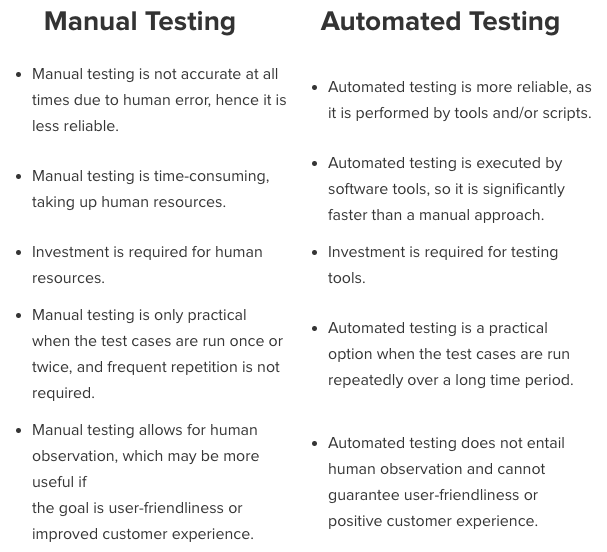What's the Difference Between Automated Testing and Manual Testing?
Learn about when you should use manual versus automated testing, like load testing automation, according to the pros and cons of each method.
Join the DZone community and get the full member experience.
Join For FreeSoftware testing is a huge domain, but it can be broadly categorized into two areas: manual testing and automated testing.
Both manual and automated testing offer benefits and disadvantages. It’s worth knowing the difference, and when to use one or the other for best results.
In manual testing (as the name suggests), test cases are executed manually (by a human, that is) without any support from tools or scripts. But with automated testing, test cases are executed with the assistance of tools, scripts, and software.
Testing is an integral part of any successful software project. The type of testing (manual or automated) depends on various factors, including project requirements, budget, timeline, expertise, and suitability. Three vital factors of any project are of course time, cost, and quality - the goal of any successful project is to reduce the cost and time required to complete it successfully while maintaining quality output. When it comes to testing, one type may accomplish this goal better than the other.
Manual vs. Automated Testing: the Pros and Cons
Manual testing and automated testing cover two vast areas. Within each category, specific testing methods are available, such as black box testing, white box testing, integration testing, system testing, performance testing, and load testing. Some of these methods are better suited to manual testing, and some are best performed through automation. Here’s a brief comparison of each type, along with some pros and cons:

When Should I Use Manual vs. Automated Testing?
In short, manual testing is best suited to the following areas/scenarios:
- Exploratory Testing: This type of testing requires the tester’s knowledge, experience, analytical/logical skills, creativity, and intuition. The test is characterized here by poorly written specification documentation, and/or a short time for execution. We need the human skills to execute the testing process in this scenario.
- Usability Testing: This is an area in which you need to measure how user-friendly, efficient, or convenient the software or product is for the end users. Here, human observation is the most important factor, so a manual approach is preferable.
- Ad-hoc Testing: In this scenario, there is no specific approach. It is a totally unplanned method of testing where the understanding and insight of the tester is the only important factor.
Automated testing is the preferred option in the following areas/scenarios:
- Regression Testing: Here, automated testing is suitable because of frequent code changes and the ability to run the regressions in a timely manner.
- Load Testing: Automated testing is also the best way to complete the testing efficiently when it comes to load testing. Learn more about load testing with our best practices guide.
- Repeated Execution: Testing which requires the repeated execution of a task is best automated.
- Performance Testing: Similarly, testing which requires the simulation of thousands of concurrent users requires automation.
Keeping these factors in mind, you can find the best approach in any given testing situation and achieve quality output well within your budget and timeline.
Published at DZone with permission of Whitney Donaldson, DZone MVB. See the original article here.
Opinions expressed by DZone contributors are their own.

Comments